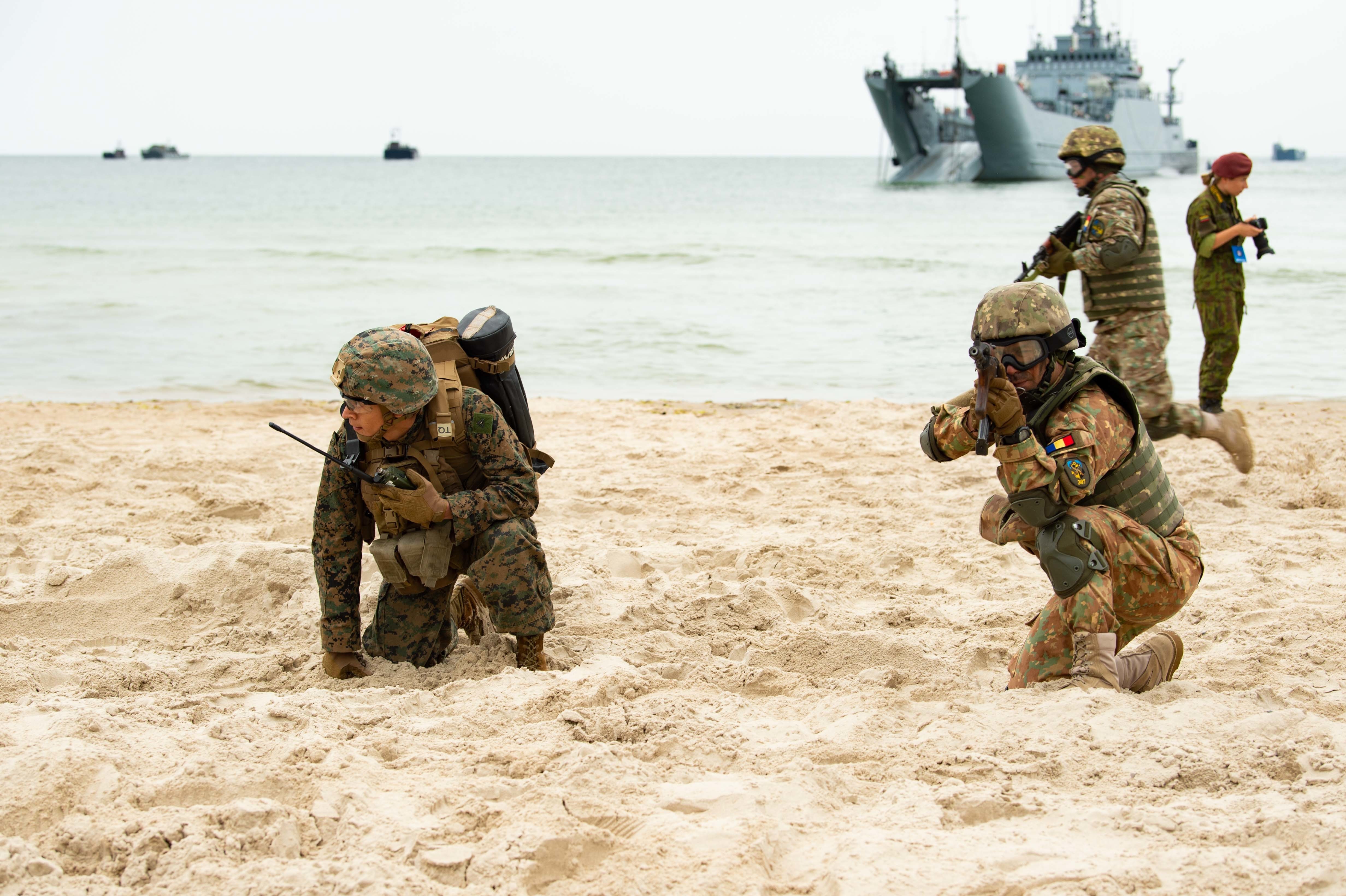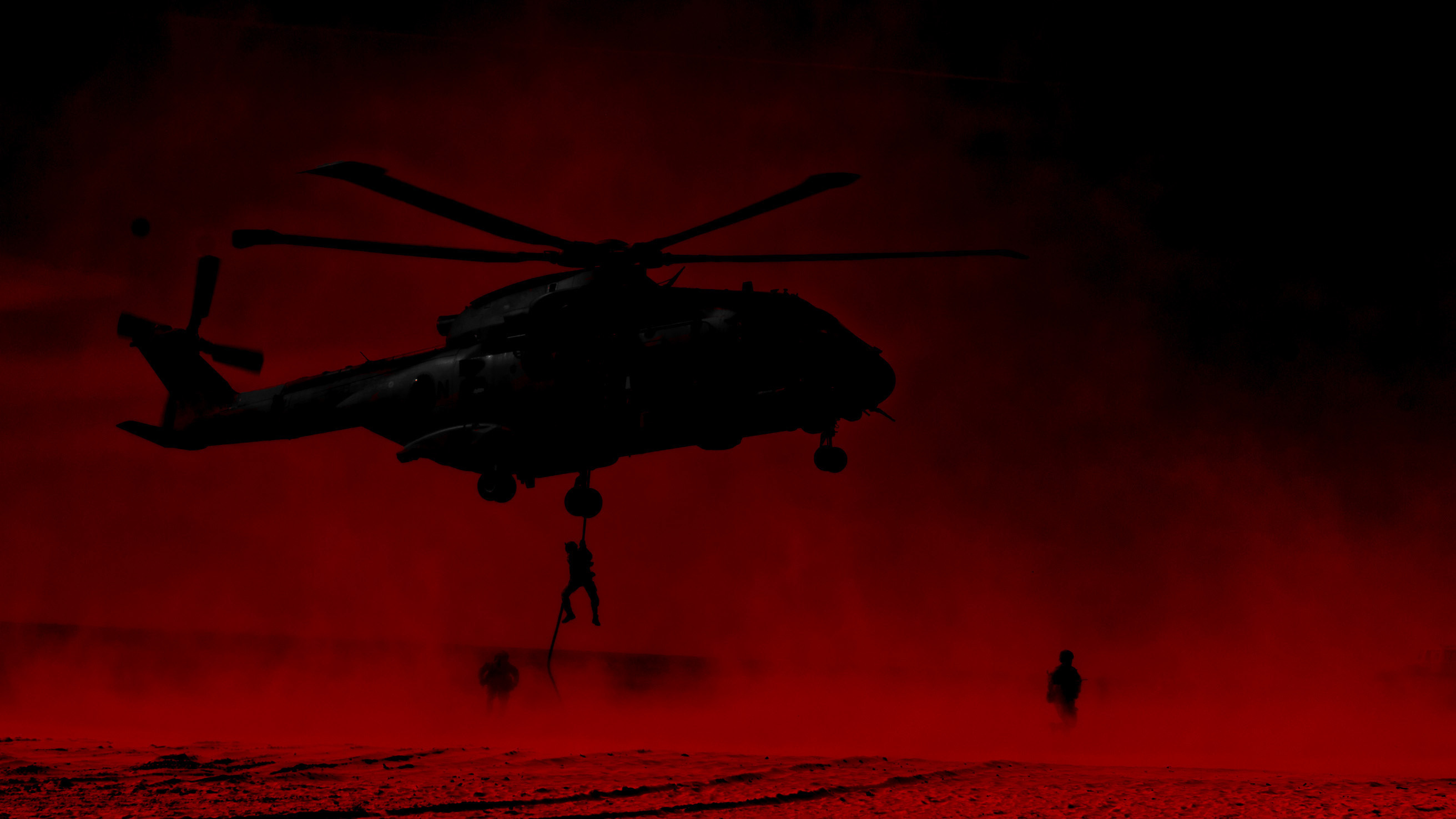
ABOARD USS MOUNT WHITNEY, IN THE BALTIC SEA – Amphibious forces in BALTOPS 2019 tested out new, high-end tactics for the first time in a live exercise, working in a less-rigid structure that allows enablers like air-defense or anti-submarine ships, mine clearance teams and artillery units to flow through the operating area to where they can do the most good.
Dozens of NATO flag officers over three years worked together to craft these new tactics through the NATO Amphibious Leaders Expeditionary Symposium (NALES) series. BALTOPS 2019, with the amphibious forces under the command of U.S. Navy Rear Adm. Brad Skillman and U.S. Marine Corps Maj. Gen. Stephen Neary, was the first opportunity to test out these tactics that deliver more combat power but take a lot more work to execute.
Skillman, whose day job is commanding Expeditionary Strike Group 2, told USNI News during the exercise that a major exercise would typically have one amphibious task force, but BALTOPS fielded two full-sized amphibious task forces to try out the new tactics, which involve flowing forces between task forces as needed.
“The power of it is, it’s designed to integrate forces,” Skillman said.
“When I form an [amphibious operating area] and I bring in these separate multinational groups … historically they’ve all operated independently. We gave them their own beaches; we gave them their own land mass; we said, these are your objectives and these are all your escorts, don’t mix and match. Well, we’ve kind of broken barriers in the alliance to say, let’s mix and match.”

“I have a force protection requirement to be able to enable the general to put his Marines ashore,” he continued.
“There may be one location of all those landings that are going on that require more – I have submarine threats on this group, but they don’t have submarine ships assigned from the U.S. side. The French have great anti-submarine frigates, so I’ll put those over and apply them here. One group needs more mine warfare; I’ll move the mine warfare group that may be owned by the British over to do that beach. So I’ll distributed our relatively limited forces to be better than the sum of the parts. There’s a lot of power in that.”
The BALTOPS command structure included two amphibious task forces. One was the British-led Joint Expeditionary Force (Maritime) unit, which was stood up last year and used BALTOPS 2019 as part of its inaugural deployment, along with a British landing force. Second was a task group formed for the exercise that included U.S. dock landing ship USS Fort McHenry (LSD-43); Spanish flagship ESPS Juan Carlos I (L-61) and air defense frigate ESPS Cristobol Colon (F-105); Polish landing ship ORP Gniezno (822); and others, along with a multinational landing force.
Skillman described his and Neary’s role in the exercise as “between a fleet and a group,” which allowed them to command their forces while also taking a wider view of the operation and prioritizing resources among the multiple task forces and their differing objectives.

“Instead of each of those individual groups going up to [U.S. 2nd Fleet commander and BALTOPS 2019 commander Vice Adm. Andrew Lewis] and saying, I need an additional escort; I need additional fires; I need additional air support – we consolidate those requests, we prioritize across all of the groups based on what the enemy is providing as a dilemma for us, and then we assign the forces that we have to take care of that,” Skillman said.
“And if we can’t achieve that with what we have, we’ll then go up – as one voice – to the fleet commander and say, hey, boss, we need more. It’s designed so he can look at – because he’s going to have all those other warfare areas to deal with – we’ve consolidated this and organized it so that we could just say, we’ve got this.”
“From our perspective, we know really well that we win wars on land. We lose wars at sea, but we win wars on land, and I have to get [Neary and his forces] there so that he can do his job,” Skillman continued.
Neary, who commands the 2nd Marine Expeditionary Brigade, said the U.S. amphibious force brings a lot of capability to a fight, but a winning strength is the allies and partners it would also include.
“As we confront today’s challenges, if we want to deter somebody, it’s better to have more friends on your side than not to have anybody. And so as we look to prioritize capability and capacity for the land forces, we do something quite similar” to what Skillman described, Neary said during the joint interview.
“If one country has more HIMARS rocket-propelled artillery, things like that, more air capability, how do we ensure success and prioritize the main effort? … Different nations bring different capabilities, and that’s strength.”
Neary described the forces he was commanding in BALTOPS, saying that, at that point in the exercise, he had Spanish Marines operating in Latvia with Spanish AV-8B Harriers and air naval gunfire liaison company (ANGLICO) liaisons, as well as Fort McHenry and Gniezno projecting ashore a company of U.S. Marines with Romanian and Spanish platoons integrated in.

“When a crisis occurs, it’s who can come to the table. Then you recognize them for what they have to bring, and then that’s the art mixed with the science that you go ahead and produce your scheme of maneuver to deal with the situation based on what you have,” Neary said, which makes it all the more important to have a command and control structure that allows those sometimes limited resources to be put where they can contribute the most to the battlefield, rather than maintaining pre-established boundaries between task forces that are easier to manage but may leave some groups without the support they need for a particular mission.
Noting that the new NALES amphibious tactics are more complex but also more dynamic, Neary said, “today’s operational environment is very complex – there’s a lot of competitive space out there, and we need to be relevant to the speed of the problem. Today’s problems are very fast, and if you’re not relevant to the speed of the problem, you could give up space – space in the air, land, sea, cyber, and space – that you’ll have to go ahead and somehow take back, acquire back. And we’ve just got to be informed by that when we start looking at indications and warnings of a crisis potentially brewing. Can you deter? What do you have to deter with?”
Skillman said that, compared to other recent amphibious exercises such as Trident Juncture 2018, which focused on cold-weather skills in Norwegian waters, for BALTOPS 2019 “we have designed a varsity-level, high-end-fight exercise. We’re trying to do it in 12 days – it’s challenging, it’s stretching people.”
From a deterrence perspective, though, he said it was important to demonstrate these skills in this particular region of the world.

“We’ve got to get back, because there’s a half-life of naval deterrence. We can’t do it by putting rotating troops on the ground. We do it by going with ships and putting Marines on the beach,” Skillman said.
Neary also praised the exercise for showing that “our audio matches our visual. So, you say you can do it, that’s one thing. To do it is another. I think that’s important for the alliance to show how strong and committed people are to the alliance.”
The general also noted that the U.S. amphibious force is upping its game at home, embracing the new Expeditionary Advance Base Operations and the Littoral Operations in a Contested Environment concepts to prepare for a higher-end fight in the future.
Asked how BALTOPS and the new NALES tactics feed into that transition to the EABO concept back in the U.S., Neary said, “this is our laboratory. So you think about expeditionary advance base operations, so as you come through here (pointing on a map to the Danish Straits to enter the Baltic Sea), if you can present any adversary multiple dilemmas, that’s what you try to do in this competitive space. So not being predictable. How flexible can you be as you operate in the area? Can you operate for limited duration to keep them guessing?”





